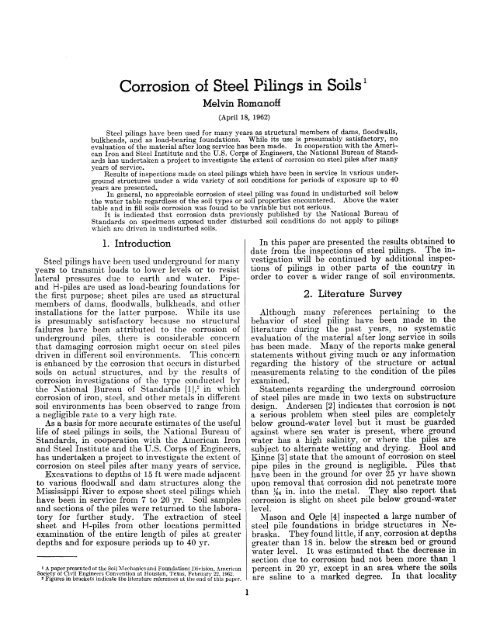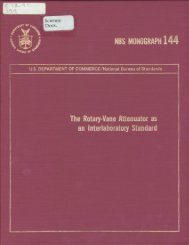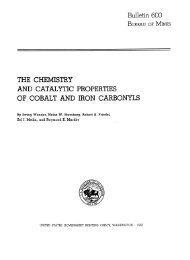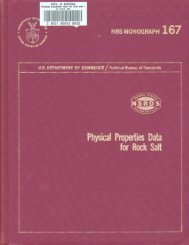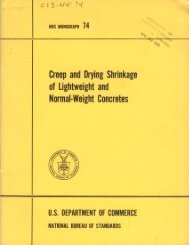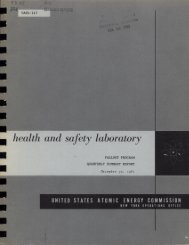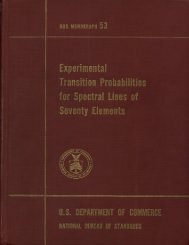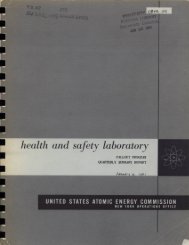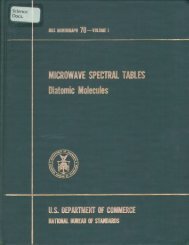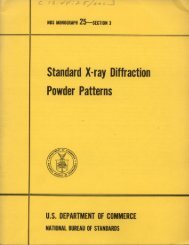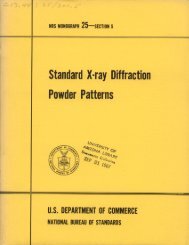Corrosion of Steel Pilings in Soils
Corrosion of Steel Pilings in Soils
Corrosion of Steel Pilings in Soils
- No tags were found...
Create successful ePaper yourself
Turn your PDF publications into a flip-book with our unique Google optimized e-Paper software.
<strong>Corrosion</strong> <strong>of</strong> <strong>Steel</strong> <strong>Pil<strong>in</strong>gs</strong> <strong>in</strong> <strong>Soils</strong> 1Melv<strong>in</strong> Roman<strong>of</strong>f(April 18, 1962)<strong>Steel</strong> pil<strong>in</strong>gs have been used for many years as structural members <strong>of</strong> dams, floodwalls,bulkheads, and as load-bear<strong>in</strong>g foundations. While its use is presumably satisfactory, noevaluation <strong>of</strong> the material after long service has been made. In cooperation with the American Iron and <strong>Steel</strong> Institute and the U.S. Corps <strong>of</strong> Eng<strong>in</strong>eers, the National Bureau <strong>of</strong> Standards has undertaken a project to <strong>in</strong>vestigate the extent <strong>of</strong> corrosion on steel piles after manyyears <strong>of</strong> service.Results <strong>of</strong> <strong>in</strong>spections made on steel pil<strong>in</strong>gs which have been <strong>in</strong> service <strong>in</strong> various underground structures under a wide variety <strong>of</strong> soil conditions for periods <strong>of</strong> exposure up to 40years are presented.In general, no appreciable corrosion <strong>of</strong> steel pil<strong>in</strong>g was found <strong>in</strong> undisturbed soil belowthe water table regardless <strong>of</strong> the soil types or soil properties encountered. Above the watertable and <strong>in</strong> fill soils corrosion was found to be variable but not serious.It is <strong>in</strong>dicated that corrosion data previously published by the National Bureau <strong>of</strong>Standards on specimens exposed under disturbed soil conditions do not apply to pil<strong>in</strong>gswhich are driven <strong>in</strong> undisturbed soils.1. Introduction<strong>Steel</strong> pil<strong>in</strong>gs have been used underground for manyyears to transmit loads to lower levels or to resistlateral pressures due to earth and water. PipeandH-piles are used as load-bear<strong>in</strong>g foundations forthe first purpose; sheet piles are used as structuralmembers <strong>of</strong> dams, Goodwills, bulkheads, and other<strong>in</strong>stallations for the latter purpose. While its useis presumably satisfactory because no structuralfailures have been attributed to the corrosion <strong>of</strong>underground piles, there is considerable concernthat damag<strong>in</strong>g corrosion might occur on steel pilesdriven <strong>in</strong> different soil environments. This concernis enhanced by the corrosion that occurs <strong>in</strong> disturbedsoils on actual structures, and by the results <strong>of</strong>corrosion <strong>in</strong>vestigations <strong>of</strong> the type conducted bythe National Bureau <strong>of</strong> Standards [I], 2 <strong>in</strong> whichcorrosion <strong>of</strong> iron, steel, and other metals <strong>in</strong> differentsoil environments has been observed to range froma negligible rate to a very high rate.As a basis for more accurate estimates <strong>of</strong> the usefullife <strong>of</strong> steel pil<strong>in</strong>gs <strong>in</strong> soils, the National Bureau <strong>of</strong>Standards, <strong>in</strong> cooperation with the American Ironand <strong>Steel</strong> Institute and the U.S. Corps <strong>of</strong> Eng<strong>in</strong>eers,has undertaken a project to <strong>in</strong>vestigate the extent <strong>of</strong>corrosion on steel piles after many years <strong>of</strong> service.Excavations to depths <strong>of</strong> 15 ft were made adjacentto various floodwall and dam structures along theMississippi River to expose sheet steel pil<strong>in</strong>gs whichhave been <strong>in</strong> service from 7 to 20 yr. Soil samplesand sections <strong>of</strong> the piles were returned to the laboratory for further study. The extraction <strong>of</strong> steelsheet and H-piles from other locations permittedexam<strong>in</strong>ation <strong>of</strong> the entire length <strong>of</strong> piles at greaterdepths and for exposure periods up to 40 yr.1 A paper presented at the Soil Mechanics and Foundations Division, AmericanSociety <strong>of</strong> Civil Eng<strong>in</strong>eers Convention at Houston, Texas, February 22, 1902.2 Figures <strong>in</strong> brackets <strong>in</strong>dicate the literature references at the end <strong>of</strong> this paper.In this paper are presented the results obta<strong>in</strong>ed todate from the <strong>in</strong>spections <strong>of</strong> steel pil<strong>in</strong>gs. The <strong>in</strong>vestigation will be cont<strong>in</strong>ued by additional <strong>in</strong>spections <strong>of</strong> pil<strong>in</strong>gs <strong>in</strong> other parts <strong>of</strong> the country <strong>in</strong>order to cover a wider range <strong>of</strong> soil environments.2. Literature SurveyAlthough many references perta<strong>in</strong><strong>in</strong>g to thebehavior <strong>of</strong> steel pil<strong>in</strong>g have been made <strong>in</strong> theliterature dur<strong>in</strong>g the past years, no systematicevaluation <strong>of</strong> the material after long service <strong>in</strong> soilshas been made. Many <strong>of</strong> the reports make generalstatements without giv<strong>in</strong>g much or any <strong>in</strong>formationregard<strong>in</strong>g the history <strong>of</strong> the structure or actualmeasurements relat<strong>in</strong>g to the condition <strong>of</strong> the pilesexam<strong>in</strong>ed.Statements regard<strong>in</strong>g the underground corrosion<strong>of</strong> steel piles are made <strong>in</strong> two texts on substructuredesign. Andersen [2] <strong>in</strong>dicates that corrosion is nota serious problem when steel piles are completelybelow ground-water level but it must be guardedaga<strong>in</strong>st where sea water is present, where groundwater has a high sal<strong>in</strong>ity, or where the piles aresubject to alternate wett<strong>in</strong>g and dry<strong>in</strong>g. Hool andK<strong>in</strong>ne [3] state that the amount <strong>of</strong> corrosion on steelpipe piles <strong>in</strong> the ground is negligible. Piles thathave been <strong>in</strong> the ground for over 25 yr have shownupon removal that corrosion did not penetrate morethan K 4 <strong>in</strong>. <strong>in</strong>to the metal. They also report thatcorrosion is slight on sheet pile below ground-waterlevel.Mason and Ogle [4] <strong>in</strong>spected a large number <strong>of</strong>steel pile foundations <strong>in</strong> bridge structures <strong>in</strong> Nebraska. They found little, if any, corrosion at depthsgreater than 18 <strong>in</strong>. below the stream bed or groundwater level. It was estimated that the decrease <strong>in</strong>section due to corrosion had not been more than 1percent <strong>in</strong> 20 yr, except <strong>in</strong> an area where the soilsare sal<strong>in</strong>e to a marked degree. In that locality


